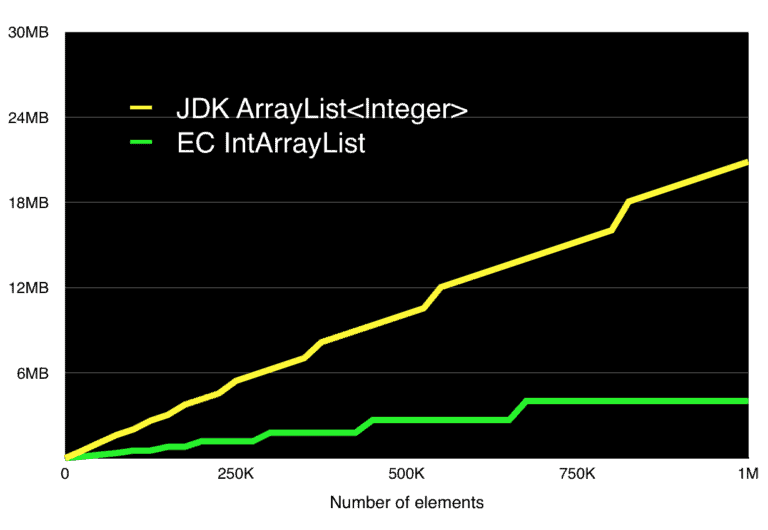1. 简介
在本教程中,我们将讨论Java中的基本类型集合以及Eclipse Collections如何提供帮助。
2. 动机
假设我们要创建一个简单的整数列表:
List<Integer> myList = new ArrayList<>;
int one = 1;
myList.add(one);
由于集合只能保存对象引用,因此在底层,该过程会将对象转换为Integer。当然,装箱和拆箱不是免费的,因此,此过程中存在性能损失。
因此,首先,使用Eclipse Collections中的原始集合可以提高速度。
其次,它减少了内存占用。下图比较了传统ArrayList和Eclipse Collections中的IntArrayList之间的内存使用情况:

图片摘自https://www.eclipse.org/collections/#concept
当然,我们不要忘记,实现的多样性是Eclipse Collections的一大卖点。
还要注意的是,Java到目前为止还不支持原始集合。不过,Project Valhalla计划通过JEP 218添加该功能。
3. 依赖
我们将使用Maven来包含所需的依赖:
<dependency>
<groupId>org.eclipse.collections</groupId>
<artifactId>eclipse-collections-api</artifactId>
<version>10.0.0</version>
</dependency>
<dependency>
<groupId>org.eclipse.collections</groupId>
<artifactId>eclipse-collections</artifactId>
<version>10.0.0</version>
</dependency>
4. long列表
Eclipse Collections为所有基本类型提供了内存优化的列表、集合、堆栈、Map和Bag,让我们来看几个例子。
首先,我们来看一个long列表:
@Test
public void whenListOfLongHasOneTwoThree_thenSumIsSix() {
MutableLongList longList = LongLists.mutable.of(1L, 2L, 3L);
assertEquals(6, longList.sum());
}
5. int列表
同样,我们可以创建一个不可变的int列表:
@Test
public void whenListOfIntHasOneTwoThree_thenMaxIsThree() {
ImmutableIntList intList = IntLists.immutable.of(1, 2, 3);
assertEquals(3, intList.max());
}
6. Map
除了Map接口方法之外,Eclipse Collections还为每个原始类型配对提供了新方法:
@Test
public void testOperationsOnIntIntMap() {
MutableIntIntMap map = new IntIntHashMap();
assertEquals(5, map.addToValue(0, 5));
assertEquals(5, map.get(0));
assertEquals(3, map.getIfAbsentPut(1, 3));
}
7. 从Iterable到原始集合
此外,Eclipse Collections还可以与Iterable配合使用:
@Test
public void whenConvertFromIterableToPrimitive_thenValuesAreEqual() {
Iterable<Integer> iterable = Interval.oneTo(3);
MutableIntSet intSet = IntSets.mutable.withAll(iterable);
IntInterval intInterval = IntInterval.oneTo(3);
assertEquals(intInterval.toSet(), intSet);
}
此外,我们可以从Iterable创建一个原始Map:
@Test
public void whenCreateMapFromStream_thenValuesMustMatch() {
Iterable<Integer> integers = Interval.oneTo(3);
MutableIntIntMap map =
IntIntMaps.mutable.from(
integers,
key -> key,
value -> value * value);
MutableIntIntMap expected = IntIntMaps.mutable.empty()
.withKeyValue(1, 1)
.withKeyValue(2, 4)
.withKeyValue(3, 9);
assertEquals(expected, map);
}
8. 原始类型流
由于Java已经带有原始类型流,并且Eclipse Collections可以与它们很好地集成:
@Test
public void whenCreateDoubleStream_thenAverageIsThree() {
DoubleStream doubleStream = DoubleLists
.mutable.with(1.0, 2.0, 3.0, 4.0, 5.0)
.primitiveStream();
assertEquals(3, doubleStream.average().getAsDouble(), 0.001);
}
9. 总结
本教程介绍了Eclipse Collections中的原始类型集合,我们展示了使用它的理由,并展示了如何轻松地将其添加到我们的应用程序中。
Show Disqus Comments
Post Directory
扫码关注公众号:Taketoday
发送 290992

即可立即永久解锁本站全部文章
